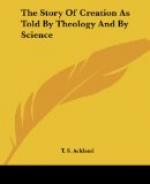The next point to be ascertained is, “Does the Mosaic Record intimate that the creations of reptiles on the fifth, and of mammals on the sixth days were entirely new creations, i.e. that no creatures of these classes had existed before?” There is no direct assertion to this effect; it is only an inference, though a natural one, when we consider the circumstances under which it was drawn. When, however, we turn to the original we find the 20th verse worded in a way which seems designed to avoid the suggestion of such an inference. Literally translated it is, “Let the waters swarm swarms, the soul of life.” Such creatures then may have existed before, but not in swarms. And in the account of the sixth day, as has been already noticed, three forms of mammalia are specified, and we have no knowledge as to the varieties included in these three forms. Nor is there here any intimation that it was the first creation of such animals. The greater part of the earlier fossils belong to the Marsupialia and Mouotremata, and we have no reason to believe that these classes have existed in historic times in Europe, Asia, or Africa. They are now confined (with the exception of the opossums, which are American) to Australia. They were therefore entirely unknown to the Jews, and in consequence necessarily omitted in a document intended for their use.
What has been said with reference to reptiles is also applicable to birds. The first traces of them are found in the ornithichnites of the new red sandstone, and the first fossil—Archaeopteryx, in the Solenhofen strata, belonging to the Oolite. From the nature of the case the remains are necessarily scanty, since birds would be less exposed than other animals to those casualties which would lead to their preservation as fossils, but enough traces have been found to show that in the period corresponding to the fifth day they were very numerous, and attained in many instances to a gigantic stature. A height of from ten to twelve feet was not uncommon.
When, therefore, we notice that the fifth and sixth days correspond to two periods, in the first of which reptiles and birds, and in the second mammalia, were the prominent types, the words of the sacred historian seem to have an adequate interpretation in that fact. There is no contradiction between the two records. Moses describes but a very few of the facts which geology has brought to light, but those few facts are in exact accordance with the results of independent observation. The acts of Creation of which Moses speaks correspond to remarkable developments of the orders of animals to which he refers. To have noticed the time of the appearance of the first individual member of each class, as distinguished from the time when that class occupied the foremost place in the ranks of creation, would have been inconsistent with the simplicity and brevity of the narrative, while it would have been unintelligible to those for whom the narrative was intended, since these primeval types had passed out of existence ages before the creation of man. It is, however, noteworthy, that the first appearances of the several orders follow precisely the same arrangement as the times of their greatest development.




